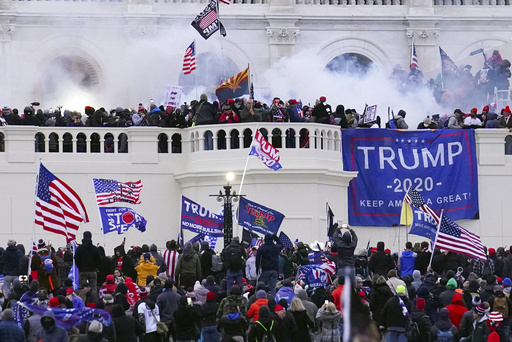WASHINGTON — In the aftermath of the 2020 presidential election, a significant number of Donald Trump’s dedicated followers responded to his claims of a stolen election by participating in a chaotic protest. This culminated in the January 6, 2021, attack on the U.S. Capitol, where hundreds, associated with extremist groups like the Proud Boys and Oath Keepers, took part in the violent events.
While many of these far-right organizations have since diminished or become less prominent, the potential for election-related violence still looms large, according to experts. As the November 5 election approaches, election officials are grappling with ongoing threats, misinformation, and the possibility of disruptive actions by election denier groups. The FBI is currently investigating incidents involving the destruction of ballots in Portland, Oregon, and Vancouver, Washington, where fires damaged hundreds of pieces of election material.
Social media channels have been exploited by Trump to propagate violent conspiracy theories that have now become embedded in the Republican discourse. Several of his supporters have sought to reframe the actions of Capitol rioters as those of patriotic figures reminiscent of the American Revolution, arguing that they are political prisoners. Trump further escalated tensions by asserting that he would use military force to target “enemies from within.”
Four years ago, many who participated in the Capitol incursion lacked prior criminal records or affiliations with extremist groups other than their common support for Trump, who urged them to “fight like hell.” This complicates efforts for law enforcement agencies to pinpoint and preempt potential threats. Expert Kurt Braddock from American University noted that just a single individual could cause substantial harm.
Heidi Beirich, co-founder of the Global Project Against Hate and Extremism, indicated that while extremists may not be actively focused on this election in their public online discussions, there remains an uncertainty regarding possible coordinated plans in encrypted spaces.
During this election cycle, Trump’s allies have intensified anti-LGBTQ and anti-immigrant rhetoric, encouraging extremist factions. For example, the Proud Boys held protests targeting drag queen story hours, and recently in Springfield, Ohio, a series of hoax bomb threats surged following Trump’s comments about Haitian immigrants.
Mainstream platforms have seen an unchecked proliferation of far-right conspiracy theories, including falsehoods surrounding the federal government’s response to hurricanes in North Carolina, a pivotal state in the upcoming elections. Trump’s recent rallies have become venues for overt racism and xenophobia, with Vice President Kamala Harris labeling him a fascist in reference to alarming remarks made by his former chief of staff regarding Adolf Hitler.
Recently, Trump survived two assassination attempts, one of which involved gunfire. He has criticized Democrats for allegedly creating a precarious political atmosphere while he is accused of being a threat to democracy. Experts like Beirich caution that it remains challenging for authorities to manage election-related threats due to the potential for incidents to unfold across the nation. Some worry that extremists might target ballot counting operations, particularly in battleground states. Beirich described the current environment as a “calm before the storm.”
Concerns extend beyond experts, as a recent poll indicates that about 40% of registered voters express significant worry over possible violence aimed at contesting the results of the upcoming election. A review of over 1,500 defendants charged in connection with the January 6 attack reveals that more than 200 had ties to extremist groups, including approximately 80 associated with the Proud Boys and over 30 linked to the Oath Keepers.
Historically, Trump once urged the Proud Boys to “stand back and stand by” during his first debate with Joe Biden, a statement that the group’s leaders celebrated, ultimately mobilizing at his “Stop the Steal” rally in Washington. Presently, key leaders from both the Proud Boys and Oath Keepers are serving lengthy prison sentences for their roles in attempting to thwart a peaceful presidential transition.
The incarceration of these leaders has created a gap, partially filled by local chapters that adopt an increasingly extreme belief system, as stated by Jared Holt from the Institute for Strategic Dialogue. He also noted that the groups’ organizational strength has waned since 2020, although a resurgence could occur if circumstances shift.
The Oath Keepers have particularly struggled since the arrest of their founder, Stewart Rhodes, with no significant figure emerging to take his place. Meanwhile, several rioters were affiliated with the Three Percenters or militia groups with names such as the Southern Indiana Patriots. Beirich observed that while militia activities have seen a notable decline, they do not entirely disappear.
A considerable number of January 6 rioters were inspired by QAnon, which posited outlandish claims about a supposed battle against a cabal of powerful figures involved in child trafficking. Mike Rothschild, who studied the QAnon phenomenon, noted its evolution away from its original conspiracies.
Following the events of January 6, social media platforms implemented measures against QAnon, redirecting its proponents to less regulated spaces like Telegram and Trump’s Truth Social platform. Rothschild highlighted that many of these individuals have returned to Twitter, now rebranded as “X,” following its acquisition by Elon Musk, emphasizing that they continue to pose a significant risk moving forward.
In summary, the situation surrounding political extremism and potential violence as elections approach remains precarious and deserving of close attention as both authorities and citizens navigate an increasingly divided political landscape.
